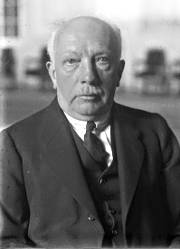ORFEO International
News
June 2014
Richard Strauss 150th Anniversary
Unlike many of his composing colleagues, Richard Strauss succeeding in promoting his preferred interpreters on the world’s stages and concert podiums. This fact is reflected, too, in the Orfeo catalogue. We have the official Salzburg world première of Die Liebe der Danae under Clemens Krauss from 1952 – thus a performance “at first hand”. Then there are numerous recordings of operas and concerts from Salzburg and Vienna under the baton of Karl Böhm, the most recent being the new releases of Ariadne auf Naxos and Elektra from the Vienna State Opera.  Richard Strauss Richard Strauss
Foto: BundesarchivThese convey a truly authentic impression of the performance aesthetic that Strauss favoured for his stage and concert works – an aesthetic that also informed the work of that magician of the podium, Dimitri Mitropoulos. Today’s performers also demonstrate how our notions have continued to evolve when it comes to Strauss’s subtle art of instrumentation and the undimmed modernity of his harmonic language. At Orfeo, Andris Nelsons and the City of Birmingham Symphony Orchestra are currently charting the virtuoso path taken by the young Strauss in his symphonic poems, when he shifted from the realm of the Brahmsians to the world of the Wagnerites. This was a path that found its goal in works such as Also sprach Zarathustra and An Alpine Symphony. And all the while, Strauss was establishing a reputation as the leading German music dramatist of the early 20th century. The fact that he retained his preeminent position among opera composers was especially thanks to the generation of conductors between Böhm and Nelsons. There was Carlos Kleiber with his legendary Rosenkavalier, as well as Joseph Keilberth and Rudolf Kempe, who did not restrict themselves to the major works of the canon but also conducted the lesser-known operas such as Feuersnot, Intermezzo and Die ägyptische Helena. Then there was Wolfgang Sawallisch, who conducted all of Strauss’s operas in Munich and even recorded a rarity for Orfeo – the seldom-played Sonatina for Winds in E flat. Alongside all these great conducting names – and without wishing to ignore the importance of his baritone and bass roles – we cannot here fail to mention the sopranos and mezzos without whom Strauss’s operas and songs would be unimaginable, and of whom we can list but a few here: Lisa Della Casa, Elisabeth Schwarzkopf, Leonie Rysanek, Lucia Popp, Christa Ludwig, Brigitte Fassbaender, Edita Gruberova, Anne Schwanewilms and Adrianne Pieczonka.
top |